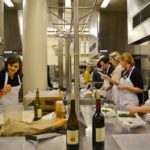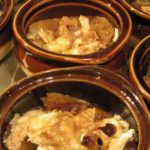Cooking a Sixteenth Century Meal Brings Food History to Life
by Emily Contois | photos by Katherine “KC” Hysmith and Rudolf Manabat
As students in Dr. Ken Albala’s Survey of Food History class (ML 622), we were overjoyed that the Food and the City Conference brought him to Boston not only to deliver the conference keynote, but to allow us the opportunity to meet him in person and cook together a sixteenth century meal.
 From our course lectures, we had learned that throughout history, specific ingredients have served as markers of social class that exude distinction. The most prestigious ingredients were often rare, expensive, and fashionable among the upper class at a certain time in a particular place. Rarity, cost, and fashion were unstable factors, however, meaning that the symbolic potential of ingredients evolved over time. The existence and expansion of trade networks, and globalization more generally, also played a significant role in specific ingredients securing elite status, while others did not.
From our course lectures, we had learned that throughout history, specific ingredients have served as markers of social class that exude distinction. The most prestigious ingredients were often rare, expensive, and fashionable among the upper class at a certain time in a particular place. Rarity, cost, and fashion were unstable factors, however, meaning that the symbolic potential of ingredients evolved over time. The existence and expansion of trade networks, and globalization more generally, also played a significant role in specific ingredients securing elite status, while others did not.
Trends and fashion made certain ingredients signs of social distinction. The variables of rarity and cost influenced trends, which tended to occur in cyclical and reactionary patterns. Culinary fashions changed for a variety of reasons, among them political, economic, cultural, and even due to changes in weather and climate. Culinary fashion often changed as ingredients became more commonplace and inexpensive, thus increasing their accessibility for the middle and lower classes and diminishing their symbolic potential and power for the nobility. For instance, medieval cuisine was heavily spiced as a demonstration of wealth because spices were expensive at that time. By the sixteenth century, however, spices had become more affordable, and upper class cuisine used less spices, instead emphasizing simplicity. Baroque fashion in particular emphasized elegant simplicity, rather than ostentatious cuisine, which had been popular when spices were expensive.This was in contrast to middle class cooking in the sixteenth century, which was heavily spiced due to the new affordability and accessibility of spices.

In our cooking class with Ken, the recipe for Stewe Mutton from Proper Newe Book of Cookery exhibits this transition well, as it not only calls for several herbs, but also a variety of spices: “cloves, mace, peper, saffron, and lyte salt.” As we discussed, a recipe from the sixteenth century featuring such an amalgamation of spices was one meant for the middle class for whom these ingredients were newly affordable, rather than for the nobility among which this style of seasoning had fallen out of favor.
Gathering together in the kitchen to cook, and then taste, sixteenth century recipes brought what we had learned from lectures and readings to life. The upwardly mobile aspirations of the sixteenth century middle class danced on our tongues as we contemplated the evolving meaning of specific ingredients throughout history.
Emily is a current gastronomy student and graduate assistant, editing the Gastronomy at BU blog, January-August, 2012. Check out her research in food studies, nutrition, and public health on her blog, emilycontois.com.










